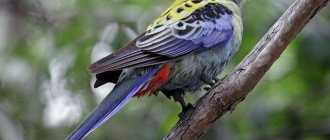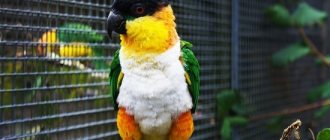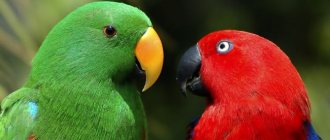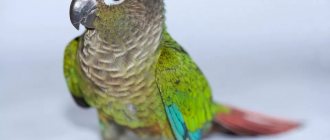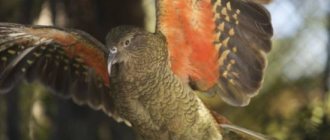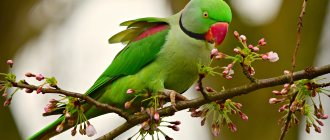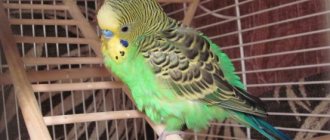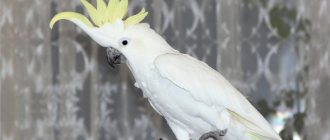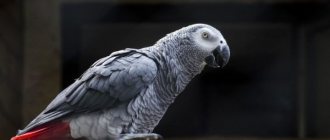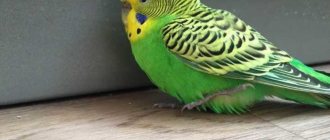Appearance of a parrot
| Name and classification | Caique parrot Pionites Psittacidae Psittaciformes Aves |
| Photo | |
| Body length | 0.2-0.25 m |
| Adult weight | 0.15 – 0.17 kg |
| Caikis are divided into two species and 5 subspecies: | ||
| Kinds | Black-headed Caique (Pionites melanocephala) | Red-headed white-bellied caique (Pionites leucogaster) |
| Subspecies | Black-capped (nominative) Western | Rufous-capped (nominative) Ecuadorian Western |
| Photo | ||
| Color | On the back of the head - black | On the back of the head - orange |
| The eye area, back, and wings are green, with blue feathers rarely visible; Undertail – orange; face, neck, throat - orange-yellow; the belly is white, sometimes with a creamy tint. | ||
| Beak | Gray-black | Beige, with a pinkish tint |
| Eyes | Orange | Orange |
| Paws | Dark gray | Dark gray |
| Tail | Straight, reaches 6 cm | Straight, reaches 6 cm |
| Sex differences | Externally, the female and male do not differ. The only way to find out gender is through a DNA test. | Externally, the female and male do not differ. The only way to find out gender is through a DNA test. |
| Features of young animals | Brown eyes at birth that turn red and then orange over time. The tummy at birth is grayish (turns white closer to the age of one year). They are born with a light gray beak (darkens at 10-12 months). | They are born with a black beak, which becomes lighter as they get older. Chicks up to a year old have brown feathers on their heads. The plumage of chicks is paler than that of adults. |
The nominal Black-headed Caique was first described by the biologist C. Linnaeus in the 18th century. But the Red-headed breed was first mentioned by ornithologist G. Berlepsh only at the end of the 19th century.
Lifespan
The average lifespan of a black-headed caique parrot is 20 years. At home, it is protected from various dangers, but in nature, a few are long-lived. There is only one officially recorded case in which a caique lived for 22.5 years.
The ringleader and the merry fellow, the “clown” caique will not leave anyone indifferent. The bird needs company and will be grateful if a feathered friend one day lives in its cage. Together, these mischievous fidgets will definitely not get bored and will always find an opportunity to amuse those around them.
Habitat and lifestyle
| Range of the black-headed species | Flocks of Kaikov are found in the countries of South America: Guyana; Guiana; Brazil; Peru; Ecuador; Colombia; Suriname; Venezuela. | Range of the red-headed species |
They inhabit the outskirts of tropical and subtropical rain forests far from human settlements. The lifestyle is gregarious (up to 20). But it is worth noting that Kaiki gather in flocks only at places of abundant feeding. At other times, they while away the days with their couple or family group. They are most active in the early morning or late evening. During the day they hide from the scorching sun among the treetops. They sleep in hollows.
They have a creaky, unpleasant voice that can be heard when feeding and flying. They fly only short distances (no more than 100 m) from their main habitat. The diet is predominantly plant-based: plants with fruits or seeds, nuts, berries. When there is a shortage of feed, they can make short forays into farmers' fields.
www.zoo-ekzo.ru – Exotic animals
Black-capped parrot, or black-headed parrot, or white-bellied parrot, or caique (Pionites melanocephala)
Class - Birds
Order - Parrots
Family – Parrots
Subfamily – True parrots
Genus – White-bellied parrots
Subspecies:
- Nominal subspecies (Pionites melanocephala melanocephala)
- The Western black-capped parrot (Pionites melanocephala pallidus) has similar coloration to the nominate subspecies, but its belly is pure white, without a yellow tint, and the feathers of the flanks and lower legs are yellow.
Appearance
Body length 23-24 cm, tail 6 cm. The coloring is very beautiful. The head, from the forehead to the back of the head, is painted black. The frenulum and ocular rings are green. The “facial” part of the head and throat are orange-yellow. The top of the neck from the border of the back to the back of the head and down to the chest is covered with a wide belt of orange-brown color, on which there are several blue feathers. The back, wings and upper side of the tail are green. The chest and belly are creamy white with a slight yellowish tint. The feathers of the lower leg, around the thigh and on the sides are orange, as is the inside of the tail. The beak is black and gray. The iris is orange. Paws are gray.
Habitat
It lives in Guyana, northern Brazil, northeastern Peru, eastern Ecuador and southern Colombia. Inhabits tropical rainforests and usually avoids human settlements.
In nature
It feeds on seeds of wild plants, fruits and nuts, but sometimes flies to corn plantations. They gather in large flocks only in areas of abundant feeding, and usually live in pairs or family groups. They are most active at dawn and in the late afternoon. At this time, they can be heard at a very long distance, because they have a very loud voice, and a very unpleasant one.
Reproduction
There are 4 eggs in the clutch, incubation lasts 26 days. The young fly out of the nest at the age of 63-68 days.
Captivity
When young black-capped parrots are kept alone in cages, they quickly become tame and can learn a few words.
For breeding, they use a nesting house measuring 30x30x50 cm with a hole 6 cm in diameter. A 3 cm layer of tree bark is placed as nesting litter. The female lays about 4 eggs, and after 26 days the chicks hatch. For the first 10-15 days, the chicks are fed only by the female, receiving food from the male. Later, the male also takes part in feeding the chicks. The young fly out of the nest at the age of 63-68 days.
Control of the nest is difficult due to the increased aggressiveness of the birds, so the progress of nesting can be monitored only during the absence of the female.
It is recommended to feed black-capped parrots with sunflower seeds, millet, preferably in panicles or soaked, corn (boiled, soaked or on the cob of various ripeness), fruits, rowan berries and other berries, carrots, oranges, grapes, bananas, etc. These parrots do not eat egg mixture They eat even while feeding chicks. As protein foods, they are offered cottage cheese with honey, minced boiled meat and white bread soaked in milk. They are also given various weeds, from which the birds select only the seeds.
The lifespan of a caique in captivity is 20 years.
Reproduction in the wild
Kaiki become sexually mature by the age of 3 years. Birds form pairs for life. But if they lose a partner, they can easily create a new family. The mating season falls on different months of the year (depending on distribution):
- Guiana, Guyana - from December to February.
- Venezuela, Peru - in April.
- Colombia, Brazil - from April to May.
- Suriname, Ecuador - from October to November.
After a short period of courtship, the female lays eggs in the hollow (one clutch contains up to 4 eggs), which she incubates for 26 days. Both parents are involved in feeding the offspring. At about 1.5 months, the chicks fledge, and closer to 2 months of age they begin to fly out of the nest. Usually, grown-up birds do not leave their parents, but continue to live nearby, forming family communities.
Despite the small size of Caikis, they build their nests in hollows at a height of at least 30 meters from the ground.
Abilities and character of the caique parrot
Black-headed and red-headed white-bellied caiques are energetic, active birds. To keep them from getting bored, they need a lot of toys: from a variety of balls and rattles to puzzle toys for parrots.
Caiques are easy to train and learn quickly. However, they are unable to imitate human speech, unlike various mechanical everyday sounds. It is worth noting that red-headed caiques can also whistle melodies they have heard previously.
Even though they have rather short legs, parrots of this species require daily walking and climbing for healthy muscle and joint development.
Caiques do not get along well with other types of parrots. Therefore, caiques should be housed in a separate cage from other birds, otherwise they will constantly fight.
Keeping at home
White-bellied parrots quickly get used to humans, are easy to train, and are unpretentious in keeping. Therefore, these birds are often kept as pets.
Which cell to choose
The cage is selected taking into account the following requirements:
- Dimensions from 80*40*60 cm (the bird must be able to freely spread its wings and jump on branches).
- Ease of operation (cleaning, cleaning, disinfection).
- Availability of equipment (feeders, drinkers, toys, perches) and mineral supplements (lime, chalk, sea sand) freely available to the birds.
The cage is cleaned twice a week, while the bird is allowed to fly around the apartment. Using a spray bottle or spray bottle, you can carry out water treatments for the bird. When using a bathtub for bathing, the water in it should be changed several times a day.
It is recommended to create an appropriate microclimate in the room:
- Air temperature - +18-+200С.
- Humidity – 60-70%.
- No drafts.
What to feed
| The Kaikov's diet should be balanced and varied. The ratio of wet and dry food is 50%:50%. | Fruits, berries: Raspberries; Rowan; Rose hip; Strawberries; Oranges; Grape; Apples; Bananas; Cherries; Pineapples. | Grain, seeds: Canary seed; Sunflower; Millet; Wheat; Millet; Corn; Ready-made grain mixtures (JR Farm, Prestige, Padovan, Fiory). | Vegetables: Carrots; Pumpkin; Lettuce leaves. |
| Greens: Spinach; Clover; knotweed; Nettle. | Branch food: Currants; Aspen; Kalina; Linden; Hawthorn; Hazel; Apple tree; Maple; Rowan. | Porridge: Millet; Oatmeal; Pearl barley; Rice. | Protein supplements: Cottage cheese (you can add a little honey); Cooked meat; Bread soaked in milk. |
| Be sure to always have drinking bowls with clean filtered water near the birds, which should be changed daily. | |||
You can avoid self-plucking and damage to property by Caique parrots if you introduce branch food (aspen, currants, poplar, linden) to the diet on an ongoing basis.
Caikis are the only species of parrots that do not eat boiled chicken eggs.
Abilities and character
Black-headed and red-headed white-bellied parrots are well trained and easy to train. Despite the fact that they cannot imitate human speech, they are happy to imitate sounds (for example, a ringing alarm clock, a car alarm, the sound of a mixer), and whistle the melodies they hear to the beat.
Birds are energetic and active. Therefore, they should have a lot of toys in their arsenal so that they do not get bored and can waste their physical strength. In addition to games, birds need to be given daily walks and the opportunity to climb. Such activities strengthen the muscles and joints of pets and prevent them from atrophying.
By nature, caiques are friendly and peaceful. They enjoy interacting with people, especially children. But they will not share territory with other species of birds. Parrots are also jealous of other pets - they will always defend their right to the attention of their owner.
Video talking parrot Caique. talking parrot Caique
How to tame
White-bellied parrots are easy to tame if they are adopted at a young age and kept alone.
The main stages of taming caiques:
- Adaptation to a new place of residence.
- Getting used to the presence of a person.
- Constant communication with birds.
- Give treats as a thank you for obedience and performing tricks.
When the bird boldly approaches its owner and begins to repeat the tasks required of him, we can assume that the taming process has been successful. But it is worth remembering that training will take from 6 to 12 months.
Breeding
Breeding caiques at home is quite possible. But to do this, you need to create the most comfortable conditions for the parrots:
- Place a pair of parrots in the spring (during the mating season) in a separate enclosure.
- Set up a nesting house for the birds (30x60x60 cm), and put a simulated nest-tray (diameter 5-6 cm) in it.
- Minimize contact with birds during the nesting period (birds become aggressive).
If mating is successful, the female lays eggs and incubates them. Caikis feed their chicks on their own. At 2 months, when the grown parrots begin to fly out of the nest, they are removed from their parents.
Video Kaik: impressions of the parrot after a month
Habits and behavior
White-bellied parrots are active, noisy and cheerful birds. They are unable to sit still for a long time and are constantly on the move. Energetic and restless birds are endowed with pronounced artistic abilities and are ready to entertain others around the clock with their funny antics.
Moreover, all their actions (from jumping and jerking their heads to hanging on one leg and falling on their back) are accompanied by cheerful chirping.
Interesting! Caiki parrots have an unusual habit - they like to constantly rub their beaks against various objects.
White-bellied birds cannot copy human speech. But caiki parrots masterfully reproduce all kinds of sounds, such as a child’s cry, the ringing of an alarm clock, or the noise of electrical appliances.
